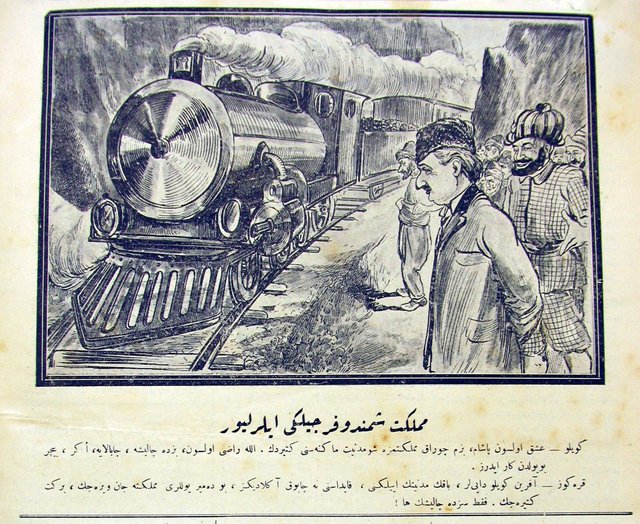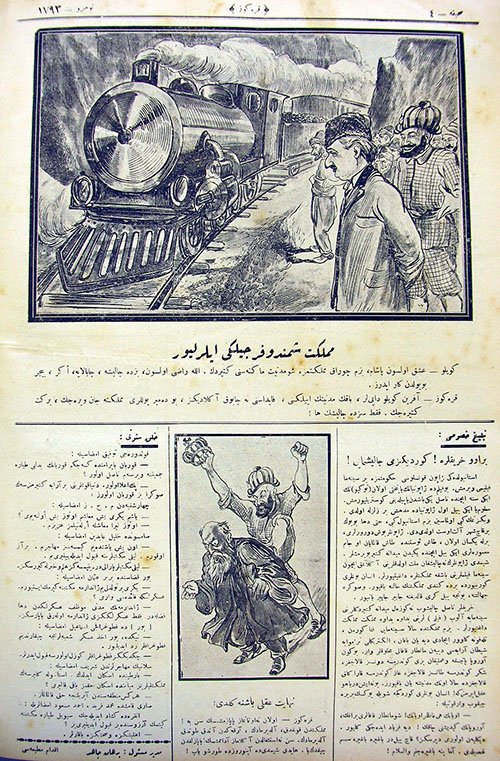182. Today in 1920s Turkey: 23 May 1925 (Bringing Trains to Villages)

(Illustration, Karagöz, 23 May 1925, no. 1793, page 4.)
Türkçe
Memleket Şimendiferciliği İlerliyor
Köylü: Aşk olsun Paşam, bizim çorak memleketimize şu medeniyet makinesini getirdin. Allah razı olsun, biz de çalışa, çabalaya, eker, biçer bu yoldan kar ederiz.
Karagöz: Aferin köylü dayılar, bakın medeniyetin iyiliğini, faydasını ne çabuk anladınız, bu demir yolları memlekete can verecek, bereket getirecek. Fakat siz de çalışın ha!
English
The Nation’s Railways Are Progressing
Villager: Well done my Pasha! You brought this machine of civilization to our arid/barren homeland. May God be pleased. We, too, will make a profit from this path by (hard) work and cultivation (of the land).
Karagöz: Good for you, uncle villager. See how quickly you understood civilization’s goodness and benefits. These railroads will give life to the country and bring abundance. But you should work, too!
Comments:
Today’s illustration announces the expansion of railways and trains into new territories of the nascent Turkish Republic (est. 1923). Laying new railroads was one of the modernizing state’s priorities, serving economic, cultural, and of course, security and defense objectives. Transportation and communication methods are at the core of developing reliable and efficient relationships between provincial and central/urban populations. The bi-weekly journal, Karagöz considered itself the voice of the people (halk) and as such, stories and news about the concerns of more rural peoples were always included in its pages. The illustration consists of a train barreling through the mountains, presumably, to arrive at a remote, and otherwise inaccessible terrain. The foreground includes identifiable figures such as Prime Minister İsmet İnönü, who was often featured alongside stories about trains, and behind him, Karagöz who was the mascot and namesake of the journal. Meanwhile, other villagers are shown as a small crowd in the background who have gathered to behold the massive machine traversing their land.
The text below the picture puts words into the mouths of the rural “villagers” as they express gratitude for the state’s service. Karagöz’s response adds a moralizing angle to the discussion as he asserts the greater benefits of modern civilization to more remote locations less affected by modern technological amenities. Karagöz’s statement ends with a quasi-contractual plea to meet the state half-way… The railroads will bring countless benefits to provincial villages but accordingly, the villagers must also work hard in order for these developments to achieve long-term results. In fact, the theme of entire nations working hard is repeated on this very page as a column located below this illustration focuses on Japan’s recent successes in mobilizing their population toward post-disaster relief and reconstruction following a devastating earthquake just two years prior. In many ways, the fallout of the Turkish War of Independence (1919-1922) required similar acts of collective cooperation and national mobilization to restore and reconstruct the country under a new administration and building new railroads was a significant part of this effort.

(Entire page, Karagöz, 23 May 1925, no. 1793, page 4. Serial publications, Atatürk Library, Istanbul.)
Like what you see? Follow the “Today in 1920s Turkey” Steemit account @yasemin-gencer, or follow me on Twitter to receive notifications for new posts @1920sTurkey.
evet yeni Türkiye Community actim, buyur sende gel ve birbirimize destek olalim https://steemit.com/trending/hive-179764
https://discord.gg/PFdrg9 bize katılmaz mısın 😇